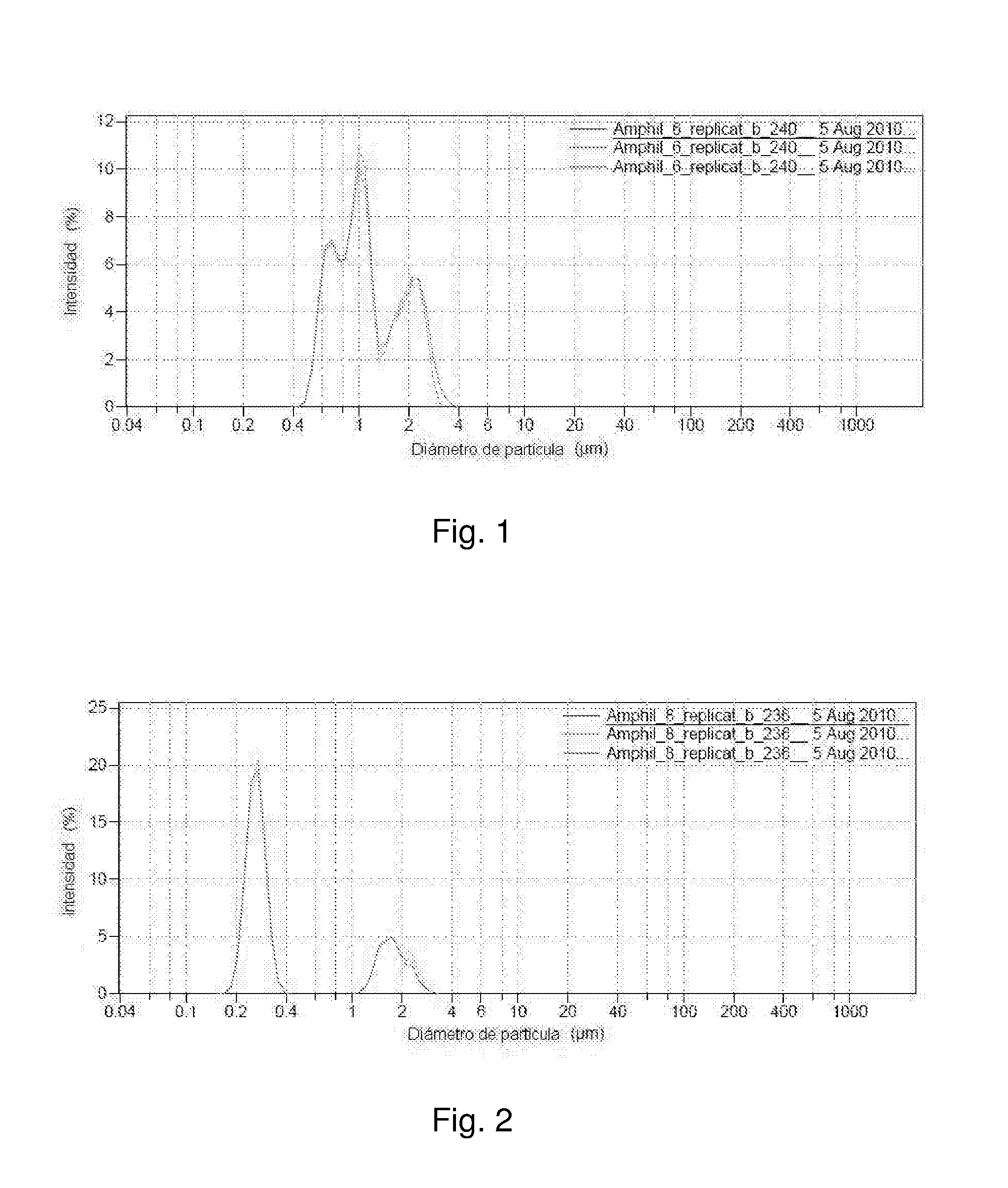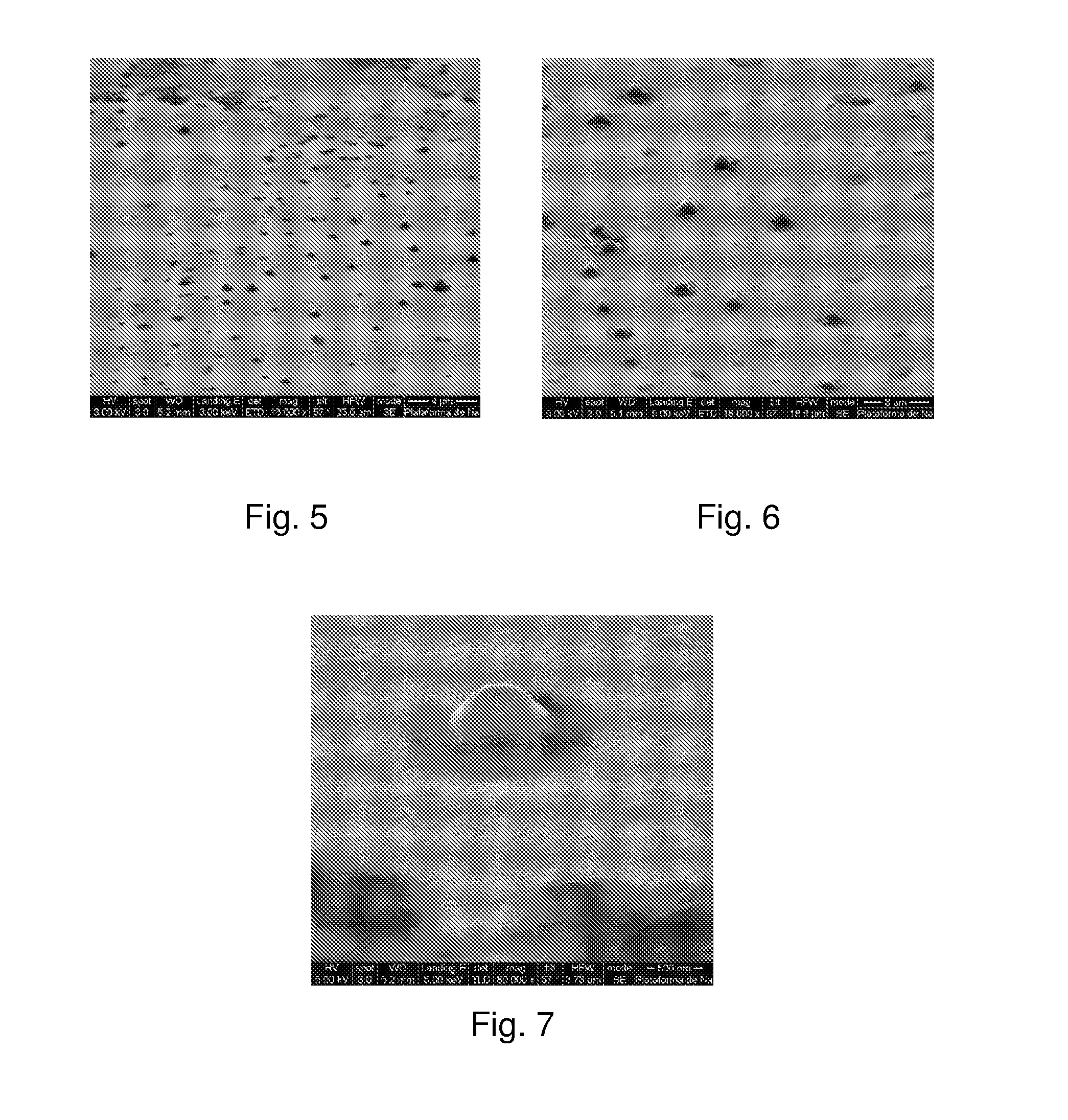Method for producing a microencapsulate and corresponding reactive amphiphilic compound, microencapsulate and composition
a technology of reactive amphiphilic compounds and microencapsulates, which is applied in the direction of botany apparatus and processes, cyclic peptide ingredients, applications, etc., to achieve the effect of less energy, less stirring equipment, and no significant solubility in water
- Summary
- Abstract
- Description
- Claims
- Application Information
AI Technical Summary
Benefits of technology
Problems solved by technology
Method used
Image
Examples
example 1
Encapsulation of Olive Oil
[0133]In a 700 ml reactor 10.53 g of IPDI (which performs the function of the first precursor), 6.38 g of Dimerdiol (which performs the function of the second precursor), 20.38 g of olive oil and 20.83 g of Ymer (which performs the function of the third precursor) were loaded. The reaction was carried out at 160 rpm, at 85° C. and with nitrogen.
[0134]After 2 hours reaction time, the reactor was cooled to below 25° C. and 3 drops of BYK-028 antifoaming agent were added, the emulsion was made at 400 rpm with 250.00 g of water, adding it slowly on top of the amphiphilic prepolymer.
[0135]Once the emulsion was complete, 3.28 g drops of EPS (which performs the function of the fourth precursor), 0.36 g of NaOH and 10.20 g of water were added. After 20 minutes 0.43 g of DETA (which performs the function of the second compound) were added. The EPS was added to combine with the prepolymer and make it more hydrophilic, but essentially it was done to include a sulphona...
example 2
Encapsulation of an Aromatic Meadow C55593P Fragrance by Lucta
[0137]In a 700 ml reactor 10.53 g of IPDI (first precursor), 6.40 g of Dimerdiol (second precursor), 20.36 g of Aromatic Meadow and 15.52 g of Ymer (third precursor) were loaded. The reaction was carried out at 160 rpm, at 85° C. and with nitrogen. After 2 hours reaction time, the reactor was cooled to below 25° C. and 3 drops of BYK-028 antifoaming agent were added, the emulsion was made at 400 rpm with 250.00 g of water.
[0138]Once the emulsion was complete, 3.17 g of EPS (fourth precursor), 0.35 g of NaOH and 10.00 g of water were added. After 20 minutes 0.79 g of DETA (second compound) were added.
[0139]A good white bluish emulsion was obtained. Using an optical microscope capsules sized smaller than 4 μm were observed. Using Light Scattering, it was observed that the capsules were sized between 0.2 and 3 μm. The population was distributed between 0.2 and 0.4 μm and again between 1 and 3 μm.
example 3
Encapsulation of Retinol 10S
[0140]Example 1 was repeated replacing the 20.38 g of olive oil with 20.34 g of Retinol 10S.
[0141]In this case a good emulsion was also obtained, but with capsules sized smaller than 10 μm. Using Light Scattering, it was observed that the capsules were sized between 0.15 and 10 μm. Most of the population was between 1 and 3 μm.
PUM
| Property | Measurement | Unit |
|---|---|---|
| sizes | aaaaa | aaaaa |
| reaction time | aaaaa | aaaaa |
| diameter | aaaaa | aaaaa |
Abstract
Description
Claims
Application Information
 Login to View More
Login to View More - R&D
- Intellectual Property
- Life Sciences
- Materials
- Tech Scout
- Unparalleled Data Quality
- Higher Quality Content
- 60% Fewer Hallucinations
Browse by: Latest US Patents, China's latest patents, Technical Efficacy Thesaurus, Application Domain, Technology Topic, Popular Technical Reports.
© 2025 PatSnap. All rights reserved.Legal|Privacy policy|Modern Slavery Act Transparency Statement|Sitemap|About US| Contact US: help@patsnap.com



